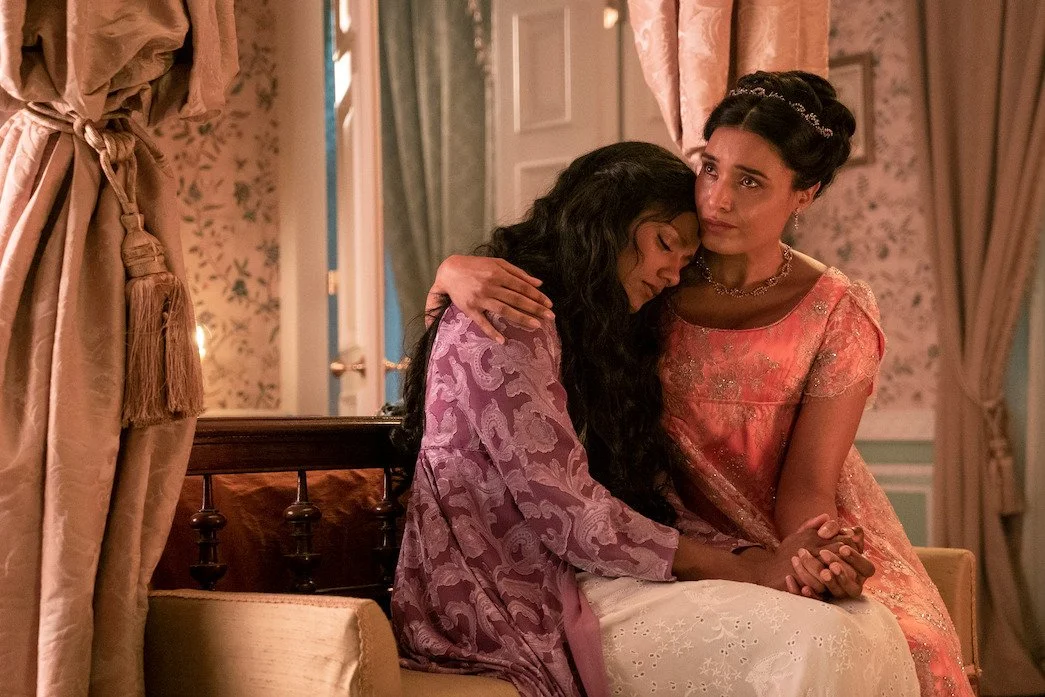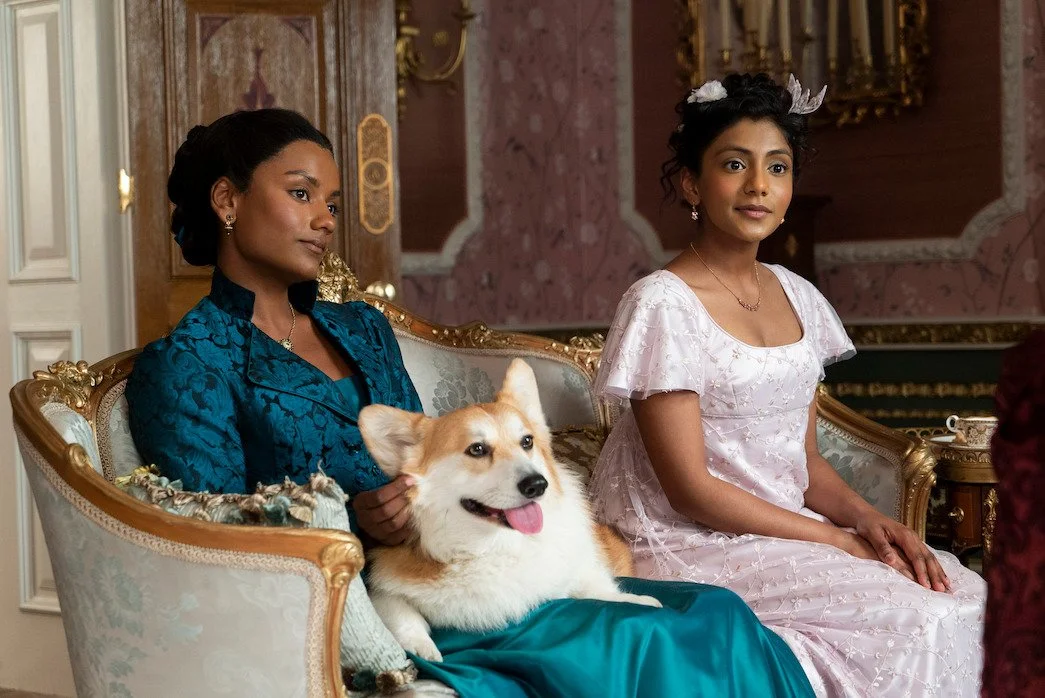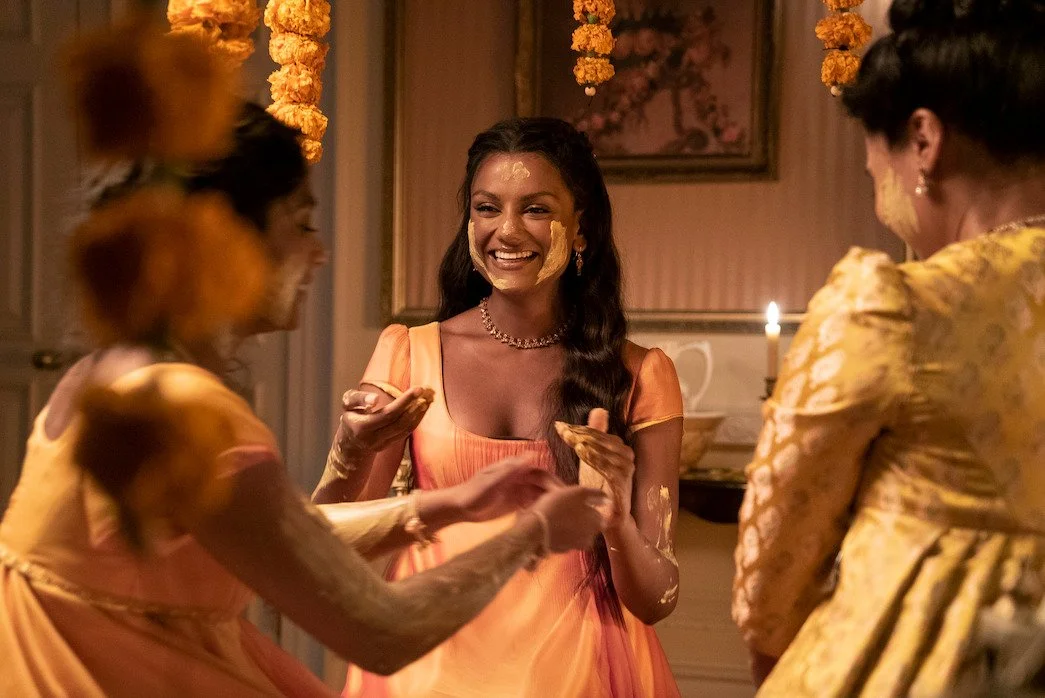The complicated yet refreshing beauty of South Asian representation in Bridgerton
Images courtesy of Liam Daniel/Netflix
Words by Ria Kakkad, edited by Dalia Al-Dujaili
I'm not the biggest fan of historical TV dramas— Downton Abbey has never appealed to me. But, when I heard Simone Ashley, a British Tamil actress, would be leading in season two, I binged the first season of Bridgerton in one weekend. I was excited, but a bit nervous, to see how and if Shonda Rhimes added any aspects of South Asian culture in the latest season.
As seen in season one, the concept of race does not seem to exist in Bridgerton, except for a small reference to Queen Charlotte's marriage removing racial barriers. The show is historically inaccurate, and justifiably, some might struggle to watch Bridgerton, where violent, colonial history has been removed. I was intrigued to see if any of Britain’s colonial ties with India would be mentioned in the show. From the beginning of the East India Company’s rule in 1757 to 1947, the year of its independence, it is hard to ignore the damages, violence and deaths as a result of the British conquest. Whilst it might be easy to do so from a script, it is impossible to erase racial trauma from lived experience and history. Furthermore, other inequalities are still present in the show, such as early capitalism and class privilege, which the Sharma sisters take advantage of. It is hard to understand what kind of role the Sharma family would have played in the real world, but since the show’s beginning, there has been a huge emphasis on its fantasy nature . Therefore, the show has been a means of escapism for me, and it's been refreshing to see Kate (played by Ashley) and Edwina (played by Charithra Chandan) not have to have to overcome racial barriers in the fantasy "-ton" they reside in.
Edwina and Kate are both objects of desire in the show— they are seen as beautiful, graceful ladies who both have the possibility to find respectable matrimonial matches for themselves. Although Kate doesn't want this for herself, it is Edwina's dream. To her favour, she is nominated the Queen's diamond of the season, which dramatically increases her chances of finding a husband. As a result, she has a line of men waiting to speak to her, although it is only Anthony she has her eye on.
Edwina does not have to overcome any barriers related to her race and ethnicity to find a match. This is rare to see, especially when it comes to dark-skinned characters. We rarely see it in Bollywood, let alone in Western media. Of course, the fact that White men desire the sisters isn't being celebrated here, but rather, story arcs and characterisation extend beyond racial barriers.
Images courtesy of Liam Daniel/Netflix
Rhonda did not just portray romantic love as the focus but also within the Sharma family itself. Traditional South Asian families tend to be structured in a patriarchal, nuclear format. However, this wasn't the case with the Sharma family. Disobeying her own family, Mary fell in love with Kate's father, eloped, and later had Edwina together. Remarriage, especially with children from previous relationships and different social classes/castes, is still taboo in South Asian culture, as seen in Bridgerton with the Sheffields. Yet, the Sharma family went against this— Mary's love for Kate, who isn't her biological daughter, was equal to hers for Edwina, and the sisters affectionately refer to each other as "didi" and "bon".
Many can relate to Kate's role in the Sharma family— the older sister who takes on the responsibility for her younger sister's and family's happiness. As mentioned towards the end of the season, Kate had made many sacrifices for the rest of the family, from not revealing true feelings about Anthony to secretly contacting the Sheffields to arrange financial support for her family. It is clear from the conversation with her mother that Kate felt that she had to earn the love of her family, even as a child. Acting as if she was happy to go back to India and work as a governess, it was evident that Kate was heartbroken about her situation.
Kate oiling Edwina's hair was another way this familial, sisterly love was expressed. It's a familiar routine in South Asian households, either with amla or coconut oil. It hydrates the hair, massages the scalp and eases tension. Likewise, the Haldi ceremony portrays a wedding preparation ceremony as an emotional and beautiful portrayal. Edwina didn't need an entire entourage or hundreds of unknown guests to attend her wedding party; her mother and sister were sufficient.
The scene felt like an ode to Bollywood, with the divas, marigold flowers. There were many other moments also. One obvious moment was the violin rendition of ‘Khabhi Kushi Khabhi Gham’, something I'm sure will be played at every single South Asian wedding. Kate gifting her mother’s bangles to Edwina on her wedding day, was a heartwarming scene which can also be found in South Asian cinemas and dramas. Ironically, it was those bangles which made a huge scene at the wedding — where else would you see a wedding stop after bangles fall to the ground and smash? Other minor details include the intimacy and stolen glances between Kate and Anthony. And the sniffing.
Images courtesy of Liam Daniel/Netflix
I share many similarities with the Sharma sisters, infusing cultural jewellery with our Western clothes and our hatred of English tea. The family were proud, and unafraid to show off their culture. In the first episode, Kate listed many of Edwina’s talents and skills, which included speaking Hindustani and Marathi, and playing the sitar and murli. It is uncommon, in Britain, for someone to be praised for being fluent in Gujarati or Urdu, for example. Usually the emphasis is on European languages, such as French.
All of these factors, including the subtle details, were added for South Asian viewers, and it felt like they were for us and us only. I felt seen, even if I was watching behind a screen. Of course, there is much improvement to be made but I'm so grateful to Shonda Rhimes for moving a step closer to authentic and considerate representation.


